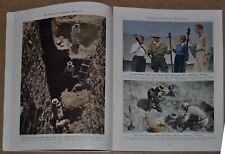|

On eBay Now...
1947 Mochica excavations magazine article, VIRU VALLEY, PERU, Archeology For Sale

When you click on links to various merchants on this site and make a purchase, this can result in this site earning a commission. Affiliate programs and affiliations include, but are not limited to, the eBay Partner Network.

1947 Mochica excavations magazine article, VIRU VALLEY, PERU, Archeology:
$10.44
Selling is a 1947 magazine article about: Mochica excavations, VIRU VALLEY, PERUTitle: Finding the Tomb of a Warrior-GodAuthor: William Duncan Strong, Loubat Professor of American Archeology, Columbia University, and Chairman, Institute of Andean Research, 1946Quoting the first page “In the Viru Valley of Peru some ten centuries ago dwelt a living god, a warrior-priest venerated by the Mochica people who developed a brilliant civilization on the northern coast when Europe was deep in the Dark Ages. Last June, on the final day of ourfield work, we were fortunate enough to discover his tomb.This editorial \"we\" represents the 1946 Columbia University Archeological Expedition to Peru, including the writer, his wife,and his assistant, Clifford Evans, Jr., who as a bombardier officer had been blown out of his plane 25,600 feet over Hamburg and less than a year before had been released from a prison camp in Germany. Now back in our own chosen study-the history of man through the millennia-we were. finding a lot to lean; and much to unlearn in Peru. New light was being shed upon the life of the vanished Mochica, who, our explorations now proved, flourished much later than had been thought. We knew at last that the period of their ascendency marked not the beginning of native civilization on the north coast of Peru, but rather its apparently brief but very brilliant flowering in the period between the Gallinazo culture, which has left us ruins of great adobe castles, and the riseof the Tiahuanaco and Chimu civilizations. Preserved in the dry soil we found intact not only examples of the splendid art work of the Mochica but some of the actual food they ate and pottery representations of their deer hunting, drinking bouts, warriors, and gods. The climax was the resurrection of old Ai apaec himself, one of the last of the Mochica warrior-priests, who had represented in his person the great-fanged feline deity of ancient Peru and was buried with the bodyof a sacrificed boy beside him. After the downfall of the Mochica there arose the Tiahuanaco civilization and the coastal empire of the Chimu kings, who, in the middle of the 15th century, dominated the northern coast of Peru from the toweringAndes to the blue Pacific Ocean. The capital of this coastal empire was the city of Chan-Chan in the Moche Valley. The ruins of that great dead city cover 11 square miles, and the many carefully planned high-walled compounds, the reservoirs, the intricate irrigation patterns, and the temple mounds, even in their present ruinous state, bespeak a very highly organized and esthetically advanced government. After flourishing for several centuries, however, the Chimu Empire and its capital were conquered by an even greater native American empire, that of the Incas. But in turn the Incas themselves were caught in the intricate web of history, and their dominance was as brief as it was brilliant. In 1532 a small but intrepid army of Spaniards under Francisco Pizarro landed on the northwestern tip of Peru, and within two years the empire of the Incas followed that of the Chimu, and the still earlier kingdom of theMochica, into oblivion. Each of these great pre-Columbian empires and kingdoms left far more than their extensive ruins, for many of the people of each survived and blended, and today their descendants form the larger part of the population of modern Peru. It was this continuity of very ancient and modern civilizations that led to the selection of the Viru Valley as the scene of a unique program in 1946. The Viru Valley Project of that year was organized by tile Institute of Andean Research, made up of North American and Peruvian scholars representing numerous universities, museums, and similar scientific…\" 7” x 10”, 30 pages, 17 B&W & 11 color photos These are pages carefully removed from an actual 1947 magazine. 47D2


1947 Mochica excavations magazine article, VIRU VALLEY, PERU, Archeology $10.44
|